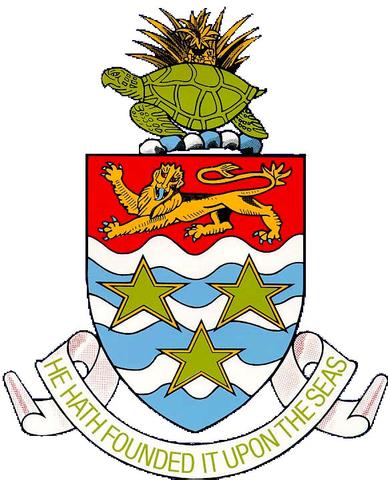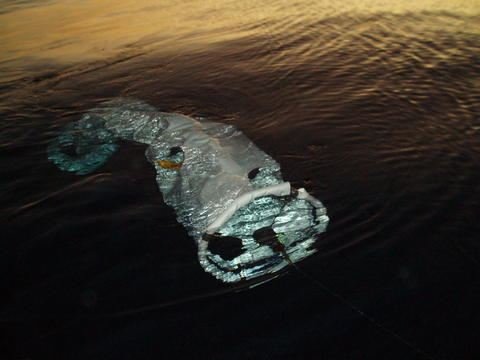
In 2011, with support from the Disney Wildlife Conservation Program, REEF developed the Baby Grouper Adrift! webpage to provide a glimpse into the potential fate of the baby Nassau grouper spawned off the Cayman Islands. Click here to visit that page.
Background
Our previous work demonstrates that all fish attending the Little Cayman spawning aggregation come only from Little Cayman, and therefore protecting this aggregation is critical to protecting the adult population. Now it is imperative that we also understand juvenile recruitment processes associated with this aggregation. Integrating adult and offspring components will be critical to the assessment and the decision making process for management of reserves of the Cayman Islands and elsewhere in the Caribbean.There is evidence that even within open ocean systems there can be a substantial amount of local larval retention. This means that local adults may be crucial to the long-term sustainability of local populations, counter to the sometimes proposed concept that larvae are transported in from other locations and therefore local adults are not important for local recruitment. In spite of the importance of this recruitment work this concept has not been tested within the Cayman Islands, nor has it to our knowledge been tested anywhere specifically for grouper aggregations.
From this work we expect to determine how oceanic current patterns over the West End Little Cayman Spawning Aggregation (WELC-SPAG) affect larval transport, how variable those currents might be, and whether there is retention of larvae within the proximity of the Little Cayman Shelf edge. Biophysical transport models will be used to demonstrate whether larval retention in proximity to Little Cayman Island might be sufficient to maintain a healthy Nassau grouper population on the island, assuming sufficient numbers of adults are allowed to spawn. It should be noted that up to 22 other species of fish use this exact same location to spawn during the winter full moon, so this place is clearly special. But why there?
Objectives
1) Deploy satellite-tracked Surface Velocity Profile (SVP) drifters in order to determine the range over which we might expect Nassau grouper larvae to be dispersed when spawned at the WELC-SPAG. 2) Work with biophysical larval advection and diffusion models to identify general patterns of larval dispersal from the WELC-SPAG, in collaboration with Claire Paris at the University of Miami. 3) Develop a general transport model for larvae originating from the WELC-SPAG.
Methods
Starting in 2008, we released Pacific Gyre, Inc. Surface Velocity Profile (SVP) GPS-Cellular drifters (Pacific Gyre, California) on the peek night of spawning. These drifters report their position by using an onboard GPS and transmit to the GlobalStar satellite phone network. Drifters are tracked for 30-45 days. They report on average 6 times per hour, 24 hours a day during the entire tracking period to ensure resolution of a scale fine enough to define the larval dispersal space. Drifter tracks are then incorporated into a GIS layer and spatially analyzed to define the potential dispersal distance that can be expected based on maximum movement of the drifters themselves. The trajectories of the drifters, including their length and their spatial pattern will provide us with the scale of the oceanographic features involved in the transport and dispersal process for larval fish. With the precision of GPS tracks, small, coastal, mesoscale oceanographic features can be sampled (for instance, a few hours and a few kilometers). The features in which the floats will be trapped will indicate an approximate distance of dispersal of larvae. Dr. Claire Paris (University of Miami-RSMAS) will be assisting us in modeling drifter movement and larval transport mechanisms associated with the field component of this work; Claire has published extensively on this topic, and will be a substantial asset to this project as we seek to understanding the underlying biophysical processes associated with larval Nassau grouper transport around the Cayman Islands. The primary goal of the modeling effort will be to work with the larval advection-diffusion transport models (HYCOM models) that she and others have developed, incorporating drifter data specific from this project to identify region-specific currents and eddies, thus characterizing potential larval transport pathways. The drifter data will allow us to tune the general model to specifically reflect processes occurring in the waters surrounding Little Cayman Island.
From this work we expect to better understand:1. How often and likely do oceanic current patterns facilitate retention of larvae within the proximity of the Little Cayman Shelf edge. 2. The timeframe within which larval Nassau grouper recruit to nearshore environments after being spawned3. The genetic relatedness of larval and early settlement juvenile Nassau grouper to the WELC-SPAG adults (this hypothesis won’t directly be answered as part of this project, but is planned through CIDOE collaboration).
2008 Drifter Track Maps and Video
The first map shows the first 12 hours of drifter movement for 1 drifter that was deployed nightly for four nights prior to mass spawning and then retrieved, and the first 12 hours of drifter movement for the 3 drifters that were deployed on 1/29/08, the night of Nassau grouper mass spawning. These drifters will transmit their positions every 10 minutes for 45 days. The remaining map images show tracks of three current drifters since their release on 1/29/08. Click on thumbnails for a larger view.
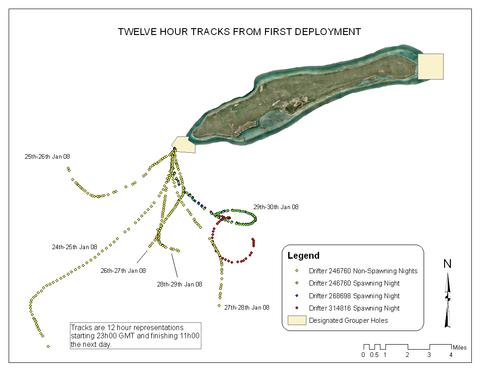
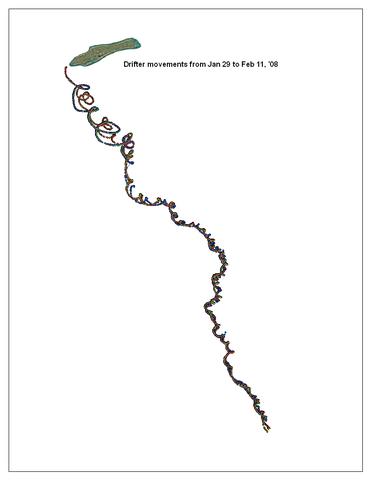
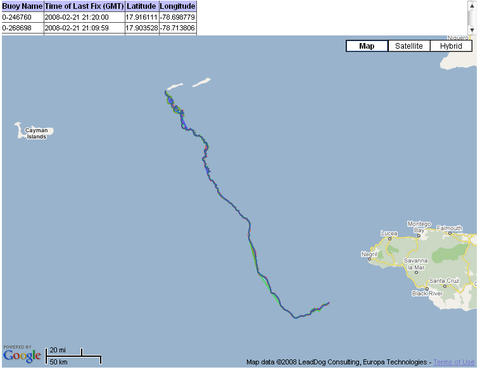
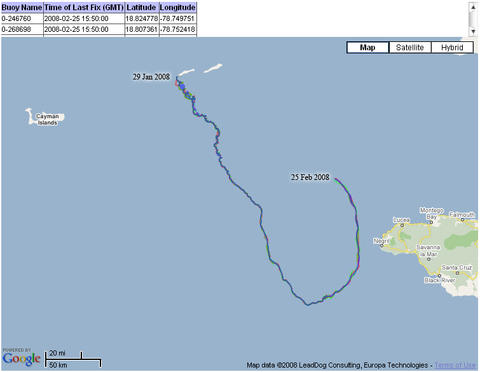
We have also developed a movie showing the drifter paths from the point of release off the west end of Little Cayman on Jan 29, 2008 through Feb 11. Click here to download the video (AVI file, 10MB).
A big thanks to James Gibb from the Cayman Islands Department of the Environment for managing the GIS for the drifter project and producing these informative maps and video. All videos, images and content from these pages are copyrighted by REEF/Grouper Moon Project. Viewing and/or downloading any content implies agreement to the terms of use. Appropriate photo/video credit and copyright information must be given and notification of their use must be provided to REEF.
